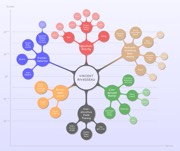The fascinating properties of light have guided our first steps in the weird quantum world. We have now acquired an in-depth understanding of the micro-world. It led to many applications and to new experimental tools. In turn, these tools allow us to unveil the most basic quantum phenomena, to realize the thought experiments repeatedly used by the founding fathers to assess their interpretation of the newborn quantum theory. We can also think of harnessing the quantum for radically new methods in information transmission and processing.
Cavity quantum electrodynamics belongs to this very active trend. It deals with a single atom interacting coherently with a few photons in a single field mode stored in a high quality cavity, a modern equivalent of Einstein's photon box. The realization of this system with circular Rydberg atoms and superconducting cavities leads to direct illustrations of the most basic quantum postulates. We count the photons in the cavity without losing them, realizing an ideal measurement of the field intensity. We use this information in a quantum feedback loop stabilizing the photon number against cavity losses. We also prepare mesoscopic quantum superpositions, reminiscent of the famous Schrödinger cat, and study their decoherence, shedding some light onto the quantum to classical transition
- Presentation

 PDF version
PDF version
